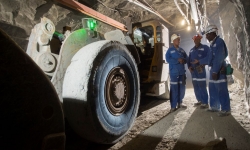Optimal shaft design - a first step to reaping the benefits of a mechanised mine
While South Africa is a mineral-rich country, its characteristic difficult geological features make it challenging to accommodate mechanisation. Research commissioned by the Mandela Mining Precinct has shown that mechanisation can be accommodated if conceptualised in the early stages of development. Through optimal shaft design, mines can produce higher volumes with a reduced labour bill and achieve increased efficiencies.
While South Africa is a mineral-rich country, its characteristic difficult geological features make it challenging to accommodate mechanisation. Research commissioned by the Mandela Mining Precinct has shown that mechanisation can be accommodated if conceptualised in the early stages of development. Through optimal shaft design, mines can produce higher volumes with a reduced labour bill and achieve increased efficiencies.
The research team, led by Thabo Gazi of the University of Pretoria’s Department of Mining Engineering, engaged a number of operating gold, platinum and coal mines in South Africa to examine the efficacy of their shafts.
“We prioritised shafts and declines that were developed in the past twenty years with a special focus on mines that mechanised parts or all of their operations,” says Gazi. A total of nine mines participated in this study and all have a variety of vertical and decline shafts.
The study forms part of the Precinct’s Mechanised Mining Systems research programme, led by Martin Pretorius. “The main aim of this study is to develop a guideline for the application of mechanised shaft infrastructure systems in an underground environment that talks to best practice in terms of hoisting, transport, tramming optimisation, and infrastructure utilisation,” says Pretorius. The Mechanised Mining Systems research programme focuses on developing solutions that would lead to the increase of economically feasible platinum and gold orebodies through new approaches.
Highlighting one of the case studies that looked at an underground copper mine at a depth of 1200m, Gazi says their shaft utilisation was at approximately 80% to 90%. “In this mine, a system design approach was followed from the beginning and each element of the design supported the other. This negated any possible bottlenecks,” Gazi says.
Turning attention to a platinum mine case study, Gazi explains how a five-barrel layout led to heightened levels of efficiencies. “Each decline served a specific purpose. For example, the first decline is for the belt system, the second is for equipment and material support, etc. and each section is then linked to a conveyer belt”.
The research team has emphasised the importance of understanding the orebody both in terms of space and direction. Mechanised mining requires planning for the whole system to function effectively and optimally. The conversion of a conventional system to a mechanised system is both challenging and costly. Gazi admits that the geology of South African reefs are characteristically difficult and often makes it difficult to accommodate mechanisation.
One of the key recommendations from the research team is to avoid retrofitting an existing conventional mine to mechanisation unless it is in a completely new mining district with sufficient ore and grades. In addition, the team recommends that the shaft infrastructure must also be able to support the higher volumes that is expected to flow from a mechanised district or section.
“In our goal to increase the feasibility of platinum and gold orebodies in South African mines. This study will provide industry with a guideline that talks specifically to the optimal design of shaft infrastructure and access the development for a typical mechanised mining system,” says Pretorius. He says the study allows the Precinct to enact its vision of maximising the returns of South Africa’s mineral wealth.
The Mandela Mining Precinct is a public-private partnership between the Department of Science and Innovation and the Minerals Council South Africa. The Precinct is proudly managed and hosted by the CSIR.




